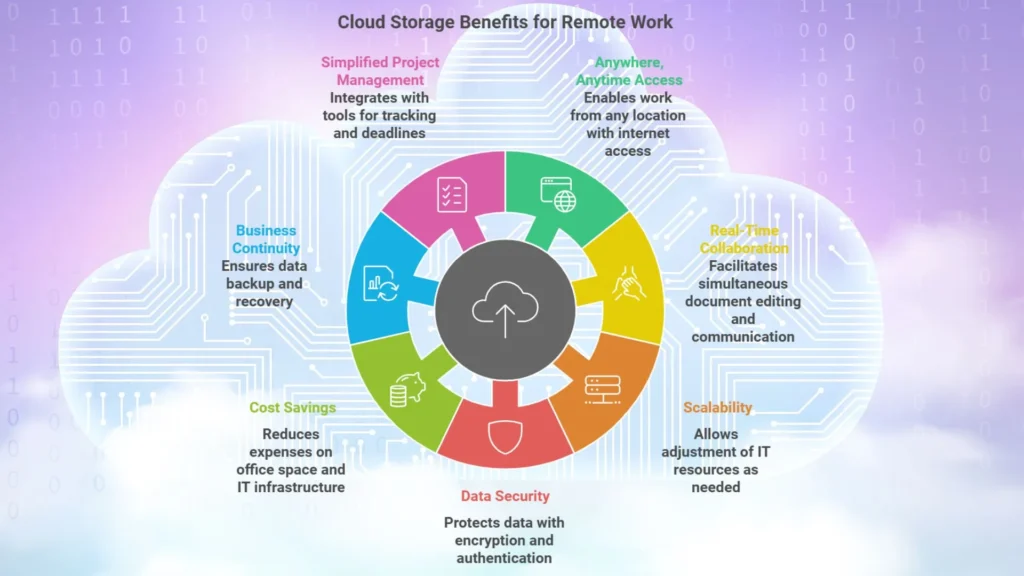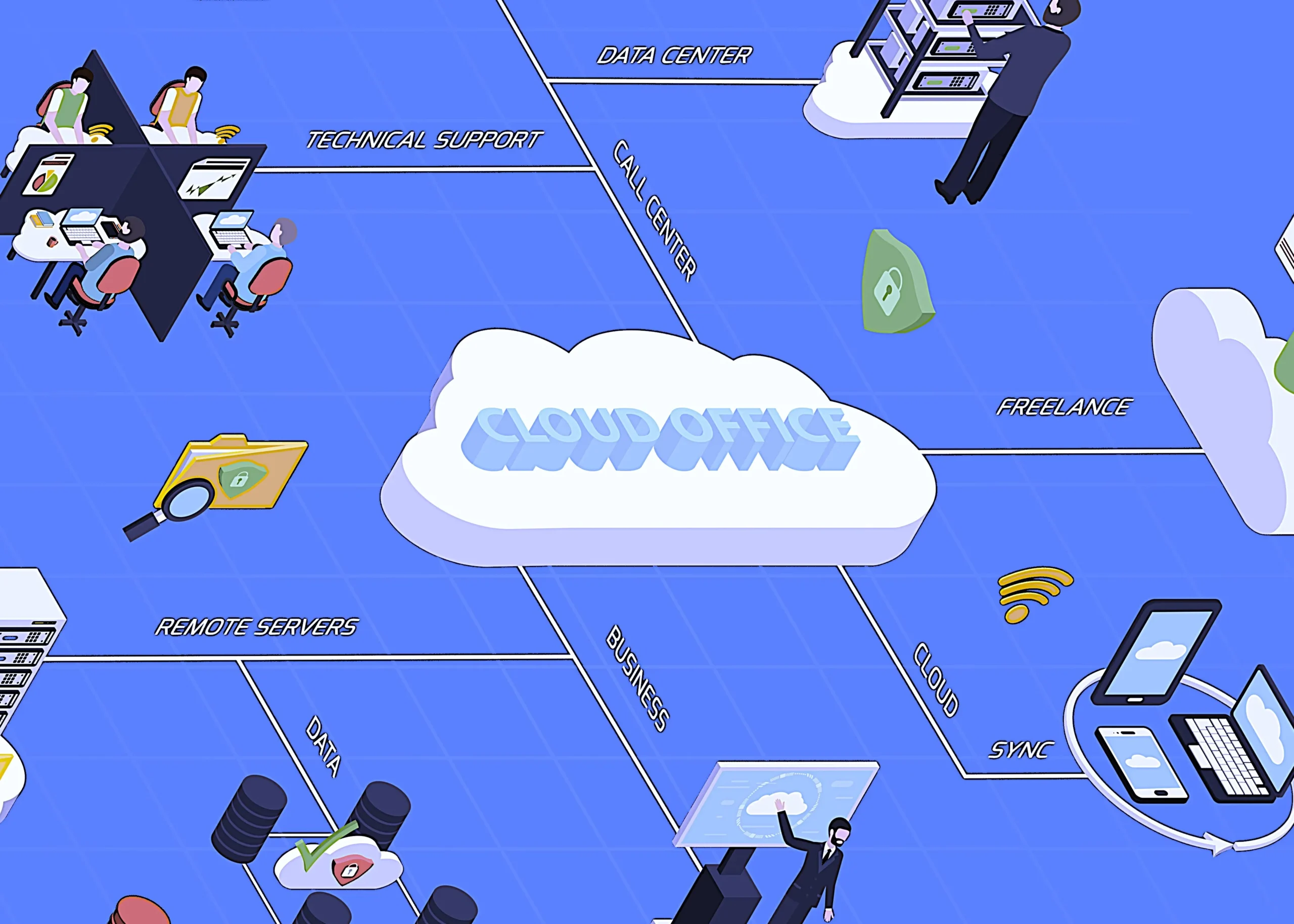Remote work has become increasingly popular post pandemic era and Cloud storage has changed the way businesses operate, especially for remote workforces. It allows teams to access, store and share data from anywhere. This provides an efficient solution to support remote work and collaboration. But, How does cloud computing enable remote work?
In this article, we shall discuss about cloud computing for remote workers. Also how cloud storage is transforming remote work and collaboration, along with tips and tools that help businesses to use it effectively. While discussing cloud computing for remote workers, we will find how does cloud computing enable remote work.
How Cloud Storage Supports Remote Work
Cloud storage works by storing data on remote servers instead of local drives, which allows users to access their files from any internet-connected device. This has many advantages for remote teams. It enables seamless access to important documents and project files without the need for physical proximity.
Here is a closer look at the key benefits of cloud computing for remote workforces:
1. Anywhere, Anytime Access:
Cloud computing allows employees to access files, applications and tools from any device with an internet connection. This ensures that work can continue seamlessly, regardless of location.
2. Real Time Collaboration:
Many cloud platforms offer real time collaboration, which allows multiple users to work on the same document simultaneously, communicate in real time and manage projects efficiently. This reduces the need for back and forth emails and keeps work synchronized.
File Sharing: Cloud storage solutions make it easy to share large files and folders securely with team members and clients.
3. Scalability:
On-Demand Resources: Businesses can scale up or scale down their IT resources based on the needs of their remote workforce. This flexibility ensures that employees have the tools they need without over committing resources.
Remote Infrastructure: Cloud platforms provide virtual desktops and applications, which allows employees to use company software and resources without the need for physical hardware.
4. Data Security:
Data Protection: Cloud providers implement robust security measures, which includes encryption, multi factor authentication and regular updates. This protects sensitive data and reduces the risk of data loss and unauthorized access.
Compliance: Many cloud services comply with industry specific regulations, which ensures that businesses meet their legal obligations even when employees work remotely.
5. Cost Savings:
Reduced Overhead: By using cloud services, businesses can reduce costs associated with maintaining physical office spaces and IT infrastructure. Employees can use their own devices, which will further lower the expenses.
6. Business Continuity:
Disaster Recovery: Cloud computing ensures that data is regularly backed up and can be easily recovered in case of an outage or disaster. This guarantees that remote work can continue uninterrupted.
7. Simplified Project Management:
Many cloud based applications integrate with project management tools, which allows teams to track progress, assign tasks and set deadlines within the same platform.

Popular Cloud Storage and Collaboration Tools
Several cloud-based platforms are widely used to facilitate remote work and project management, each has its unique features for collaboration:
1. Google Drive:
Integrated with Google Workspace, Google Drive offers secure cloud storage and collaboration tools like Google Docs, Sheets and Slides. Teams can edit documents in real time and leave comments. This makes it ideal for collaborative projects.
2. Dropbox:
Known for its user friendly interface, Dropbox provides secured storage, file sharing and integration with tools like Slack and Zoom. It allows version control and easy document sharing with permissions to manage access.
3. Microsoft Teams & OneDrive:
Microsoft Teams, paired with OneDrive, is a powerful tool for remote teams. Teams can chat, hold video meetings and collaborate on documents stored in OneDrive. This makes it a central hub for teamwork.
4. Slack with File Storage Integrations:
While primarily a messaging tool, Slack allows users to integrate with Google Drive, OneDrive and Dropbox. This makes it a useful tool for sharing documents and managing collaborative projects in real-time.
Tips for Secured Cloud Storage Use in Remote Collaboration
Cloud storage is highly beneficial, However, securing your data is essential. Here are some tips for safely using cloud storage for remote collaboration:
1. Use Strong Passwords and MFA:
Ensure all team members use strong, unique passwords and enable multi factor authentication (MFA) for added security.
2. Set Permissions Carefully:
Assign appropriate access levels based on each team member’s role to protect sensitive information.
3. Regularly Back Up Data:
Even with cloud storage, regular backups ensure you can recover data in case of accidental deletion or a security incident.
4. Educate Team Members on Best Security Practices:
Conduct training sessions to make sure everyone follows secure practices. Do not use public Wi-Fi when accessing sensitive files.
5. Monitor Activity Logs:
Many cloud storage providers offer activity tracking to monitor who accessed or edited files, which can help to detect suspicious activity.

Conclusion
Cloud computing is a foundation of remote work, which offers essential tools and services that enhance productivity and collaboration. Cloud computing provides accessible, scalable and secure options for businesses of all sizes. By adopting cloud solutions, businesses can provide employees with the flexibility to work from anywhere with operational efficiency and continuity.
By using tools like Google Drive, Dropbox and Microsoft Teams and implementing secure practices, companies can utilize the power of cloud computing and storage. This enhances productivity and helps seamless remote collaboration.
As remote work continues to grow, cloud computing and storage will remain helpful for efficient and connected work environments.
Disclaimer: The websites mentioned above might evolve over time. Always refer to the website and their official documentation for the most accurate and updated information as well as latest offerings, plans and prices etc.


Your article helped me a lot, is there any more related content? Thanks!